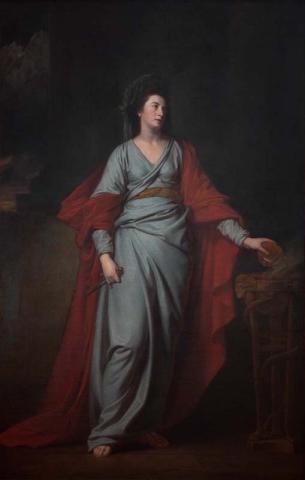George Romney and his subjects
By Sarah Tiffin
George Romney is regarded as one of Britain’s finest portraitists and his works can be found in major collections throughout the world. Born in the north of England, Romney’s father recognised his son’s talent while he was still a boy, and organised an apprenticeship for him with Steele, a northern painter who had worked in the studio of Carle van Loo in France.
In 1762, Romney virtually abandoned his wife, son and daughter (who died soon afterwards) to live in London. He rarely saw his wife again although his son, John, came to live with him in London and eventually wrote Romney’s memoirs, which were published in 1830.
Winning the Society of Arts prize for ‘Death of Wolfe’ brought him public acclaim, but the prize was later withdrawn. The suggestion that Sir Joshua Reynolds was somehow implicated in the affair led Romney to treat the more well-known artist with life-long enmity. This was a contributing factor in Romney’s refusal, despite many requests, to exhibit or become a member of the newly formed Royal Academy which was strongly supported by Reynolds.
In 1773, Romney travelled to Italy, which left a lasting impression on his art. He loved the classicism of Rome and was much impressed with Titian whose work he became familiar with when he travelled to Venice.
On his return to England, Romney became as popular and sought-after to sit for as Reynolds, whose prices were often considered excessive. Despite his success, however, Romney was a retiring man who showed little interest in politics and had few friends.
Of all his subjects, probably the most famous was Lady Hamilton, whom Romney met while she was still Emma Hart, mistress of Charles Greville. A renowned beauty, Lady Hamilton sat for Romney on numerous occasions in various characters; it is thought that of all the portraitists who painted her, it is Romney who best captured her likeness.
Melpomene, a figure featuring in Greek mythology, was one of the nine muses who were the daughters of Zeus and Mnemosyne (Memory) and were the nymphs of the two sacred springs of inspiration that were found on Mount Helicon in Boeotia. They were also thought to dwell on Mount Parnassus and this has now become their accepted place of abode. Companions of Apollo, the muses were the divine inspirations of the arts and intellectual pursuits. Each responsible for a different field of artistic endeavour in which their power was supreme, any who challenged the muses met with certain defeat and punishment.
The muses — Melpomene (tragedy), Clio (history), Euterpe (music and lyric poetry), Thalia (comedy and pastoral poetry), Terpsichore (dancing and song), Erato (love poetry and the lyre), Urania (astronomy), Calliope (epic poetry) and Polhymnia (heroic hymns) — can be identified by attributes peculiar to each.
Although these have varied since Classical times, Melpomene is generally depicted with any of a variety of attributes: a tragic mask, an ivy or cypress wreath, a sword or dagger, sceptres at her feet or a crown in her hand. The antithesis of her sister Thalia, the pair are often depicted together.
Romney chose to paint Mrs Yates as Melpomene, wearing a wreath and clutching a dagger that is thought to have his self-portrait device on its hilt. Of this work, it is recorded in Romney’s Memoirs... (compiled by John Romney in 1830): ‘This picture was highly spoken of at the time, both as a faithful likeness of that distinguished actress, and as a well conceived and correct representation of the tragic character.’
The ‘distinguished actress’ referred to in this extract was Mary Ann Yates (1728–87), considered one of the greatest actresses of the time. She played many of Shakespeare’s heroines and was well known for her portrayal of Medea in Glover’s tragedy.
Connected objects
Related artists
ROMNEY, George
1734
- 1802
Full profile
for ROMNEY, George
Metadata, copyright and sharing information
About this story
- Subject

